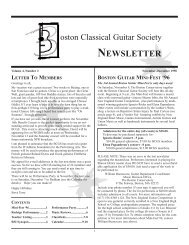2003 Jun-Aug - Boston Classical Guitar Society
2003 Jun-Aug - Boston Classical Guitar Society
2003 Jun-Aug - Boston Classical Guitar Society
Create successful ePaper yourself
Turn your PDF publications into a flip-book with our unique Google optimized e-Paper software.
<strong>Jun</strong>e/<strong>Aug</strong>ust <strong>2003</strong> BCGS Newsletter Volume 10, Number 4<br />
MINOR REPAIRS<br />
If you have developed a crack or split there are several options<br />
(including doing nothing) for repairing a broken nail. Here are<br />
a few suggestions.<br />
Glue-on plastic nails<br />
I know a guitarist or two who rely on temporary plastic nails in<br />
an emergency. When you’ve broken a nail and you have to play<br />
a gig, it can be a lifesaver. My reservation is to use them only<br />
when absolutely necessary, and remove them as soon as possible.<br />
If they’re left on too long, fungus can develop between the<br />
plastic and the natural nail, and the glues and acetone used will<br />
severely weaken your real nails, forcing you to be more dependent<br />
on the plastics. This can turn into a vicious cycle. With<br />
this in mind, the product is available through music catalogs,<br />
pharmacy stores, and fashion nail shops.<br />
Nailene, Fix a Nail–Clear, brush on superglue<br />
This product is marketed specifically for broken nails and I recommend<br />
using it over a regular tube of household superglue. It<br />
can be purchased at any Walgreen’s or CVS pharmacy. I use<br />
this on small vertical nail splits or cracks. Sometimes this product<br />
comes with vitamin E added but I don’t understand how<br />
that can be of any benefit when combined with the super glue<br />
chemicals. First, snap or press the nail back into place. This<br />
will prevent the uneven glued surfaces from creating a lump or<br />
ridge in the nail plate. Apply the adhesive sparingly with the<br />
applicator brush, Figure E, making sure that the glue makes its<br />
way into the split. Wait till it dries (a minute or two) then apply<br />
a second light coat. Once the glue has cured, use a 500 grit<br />
sandpaper to smooth out the repair. This is delicate work; if you<br />
make a mistake, use fingernail polish remover to remove the<br />
glue and start over. These are fierce chemicals on your nails, so<br />
be careful, follow the directions, use sparingly, and understand<br />
that even though you’ve repaired the split in the nail it will be<br />
less flexible than before.<br />
Kwik-Aid Nail Saver Kits<br />
This kit is available in pharmacies and catalogs, and provides a<br />
thin silk membrane or other adhesive fabric material that can be<br />
applied over a particularly bad break. This can be very effective<br />
for horizontal, side splits, see Figure F.<br />
Before applying, remove the shine<br />
on the broken nail with fine grit<br />
sandpaper, realign the nail plate,<br />
and wipe with alcohol to temporarily<br />
remove moisture. Apply a<br />
little bonding glue and let dry.<br />
Apply the patch, being careful not<br />
to handle it with your fingers<br />
since body oil will ruin its adhesive<br />
quality. When applied, burnish<br />
with a wooden stick, usually<br />
supplied, to form a tight bond<br />
over the split, Figure G. Finally,<br />
apply another light coat of bonding<br />
glue over the patch. If properly<br />
applied it will prevent the split<br />
from growing and buy you the<br />
time needed to grow it out.<br />
Both of these gluing techniques<br />
should be done sparingly. Lots of<br />
glue on the nail will create a<br />
sticky mess and take a long time<br />
to dry.<br />
Superglue repair<br />
Figure E<br />
Side split<br />
Figure F<br />
Side split adhesive patch<br />
Figure G<br />
STRANGE, EXOTIC REPAIRS<br />
Ping pong ball method (necessity is the mother of invention)<br />
This is similar to the plastic glue-ons but is unique in that the<br />
plastic nail you fashion is glued to the underside of your existing<br />
nail to extend its length.<br />
Plastic ping-pong balls have a thickness and curvature that<br />
emulate fingernails very well. The procedure for creating nails<br />
from them is to cut the ball into small crescent-shaped pieces<br />
that are the same width as your nails. Be sure that the edge to<br />
be glued has the same curve as your nail. There must be enough<br />
length to your fingernail to allow the plastic piece to be superglued<br />
to the underside. When the plastic piece is secured with<br />
glue, shape it with a file and fine grit sandpaper for a smooth<br />
finish. White is the preferable color. Florescent orange or yellow<br />
will look a little strange.<br />
When it’s time to remove them, use a small drop of nail polish<br />
remover to break the bond and clean off the superglue. Be careful<br />
that the acetone doesn’t dissolve the plastic.<br />
Hot spoon technique, not for the faint of heart.<br />
Disclaimer: I heard about this at a recent master class. It’s a<br />
technique for straightening out hooked natural nails and<br />
requires heat that could burn you or damage the nail beyond<br />
repair if you are not careful. This is for informational purposes<br />
only, so proceed at your own risk!<br />
(continued on page 13)<br />
10
















